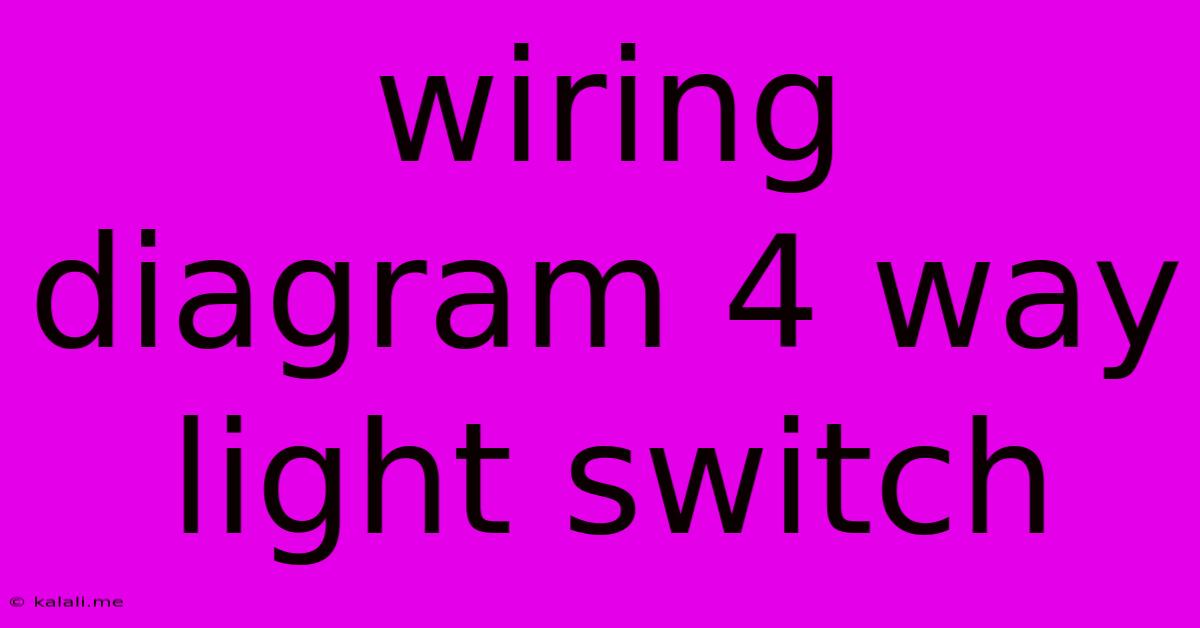Wiring Diagram 4 Way Light Switch
Kalali
Jun 04, 2025 · 3 min read

Table of Contents
Understanding 4-Way Light Switch Wiring Diagrams: A Comprehensive Guide
Meta Description: This guide provides a comprehensive understanding of 4-way light switch wiring diagrams, explaining their function, common configurations, and troubleshooting tips for both beginners and experienced electricians. Learn how to wire multiple switches to control a single light fixture.
Controlling a light fixture from multiple locations requires more than a simple two-way switch setup. This is where the 4-way light switch comes in. Unlike two-way switches which allow control from two points, a 4-way switch allows you to add additional control points beyond the initial two. This article will delve into the intricacies of 4-way light switch wiring diagrams, explaining their functionality and guiding you through the process of understanding and implementing them safely.
What is a 4-Way Light Switch and How Does it Work?
A 4-way switch is a crucial component in multi-location lighting control systems. Unlike standard single-pole switches or even two-way switches, a 4-way switch doesn't directly connect the power to the light. Instead, it acts as an intermediary, allowing the switching of the circuit between two other switches. Think of it as a "translator" between two two-way switches. You need at least two two-way switches and one or more 4-way switches to create a multi-location lighting circuit.
The 4-way switch has four terminals, each playing a vital role in the complex switching mechanism. These terminals are often labeled as "common" (although this isn't always the case) and three "traveler" terminals. The traveler terminals carry the signal between the two-way switches, enabling the control of the light from multiple locations.
Common 4-Way Switch Wiring Configurations
The simplest configuration involves two two-way switches and one 4-way switch. However, you can extend this to control lights from more locations by adding more 4-way switches. Here's a breakdown of a typical configuration:
- Two Two-Way Switches: These switches are located at the beginning and end points of the circuit. They directly connect to the power source and the light fixture, respectively.
- One or More 4-Way Switches: These switches are placed between the two two-way switches. Their function is to relay the switching signal between the two two-way switches.
Understanding the Wiring: The key is understanding the "traveler" wires. These wires connect the 4-way switches and the two two-way switches. Their arrangement allows the signal to be passed along the chain, effectively controlling the light from any location in the circuit.
Visualizing the Wiring Diagram
A visual representation is crucial for understanding 4-way switch wiring. While diagrams can vary, the core principles remain the same. A typical diagram shows the power source, the light fixture, the two two-way switches, and the connecting 4-way switches, clearly illustrating the pathways of the "hot," "neutral," and "traveler" wires. Always refer to a properly labeled and accurate diagram before attempting any electrical wiring.
Remember, safety is paramount. Always disconnect the power supply before working with any electrical wiring. Improper wiring can lead to electrical hazards.
Troubleshooting Common Problems
Even with a clear diagram, problems can occur. Common issues include:
- Light Doesn't Turn On: Check all connections, ensuring wires are securely fastened and the power supply is functioning correctly. Test each switch individually.
- Light Flickers: Loose connections or faulty switches are likely culprits. Inspect all wiring and replace any suspected faulty components.
- Switch Doesn't Respond: A faulty switch or a break in the wiring circuit could be the cause. Check all connections and test each switch.
Advanced Configurations and Considerations
While this article focuses on a basic configuration, more complex setups exist. Adding more 4-way switches allows for more control points. However, the wiring complexity increases with each additional switch. Consult a qualified electrician for complex installations.
Understanding 4-way light switch wiring diagrams might seem challenging at first, but with careful attention to detail and a methodical approach, it becomes manageable. Remember to always prioritize safety and consult professional help if you are unsure about any aspect of electrical wiring.
Latest Posts
Latest Posts
-
How To Mount Tv On Brick Fireplace
Jun 06, 2025
-
Okay Okay The Fault In Our Stars
Jun 06, 2025
-
How To Prevent Glasses From Slipping Down Nose
Jun 06, 2025
-
Best Adhesive For Pavers To Concrete
Jun 06, 2025
-
Why Was Dumbledore The Secret Keeper To Grimmauld Place
Jun 06, 2025
Related Post
Thank you for visiting our website which covers about Wiring Diagram 4 Way Light Switch . We hope the information provided has been useful to you. Feel free to contact us if you have any questions or need further assistance. See you next time and don't miss to bookmark.